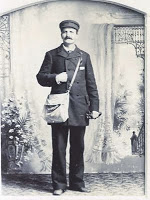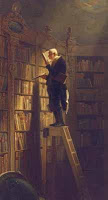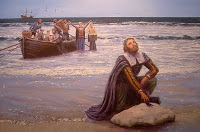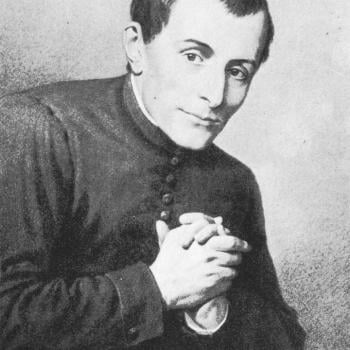 The word of God is often spoken of analogically in the scriptures. It is undergoes a typification with a bouquet of images as powerful as they are varied. It is seen as a sword, gold, honey, and countless others. It is out of this tradition that N.T. Wright draws many of his illustrations in the book The Last Word. In this work Tom lays out a careful unpacking of a very loaded term used to describe scripture: authoritative. In his view the church as a “scripture reading community” is the tool by which God is implementing “his saving plan for the cosmos” which was “inaugurated by Jesus.” As the church, we should know how to go about “reading scripture.”
The word of God is often spoken of analogically in the scriptures. It is undergoes a typification with a bouquet of images as powerful as they are varied. It is seen as a sword, gold, honey, and countless others. It is out of this tradition that N.T. Wright draws many of his illustrations in the book The Last Word. In this work Tom lays out a careful unpacking of a very loaded term used to describe scripture: authoritative. In his view the church as a “scripture reading community” is the tool by which God is implementing “his saving plan for the cosmos” which was “inaugurated by Jesus.” As the church, we should know how to go about “reading scripture.”The Suitcase
 In Tom’s view many of our terms are like suitcases that we pack up with meaning and use as shorthand so we don’t spend our entire conversation going over semantics. He points out that these suitcases do tend to start rotting after a while and must be unpacked to keep the words fresh. The authority of Scripture must be taken to mean “the authority of God exercised through scripture.” God is the one with the authority and the scripture should not be taken as authoritative apart from him.
In Tom’s view many of our terms are like suitcases that we pack up with meaning and use as shorthand so we don’t spend our entire conversation going over semantics. He points out that these suitcases do tend to start rotting after a while and must be unpacked to keep the words fresh. The authority of Scripture must be taken to mean “the authority of God exercised through scripture.” God is the one with the authority and the scripture should not be taken as authoritative apart from him.The Letter Carrier
 Tom expresses this idea further in his discussion of the bible through the anecdote of a letter carrier. Many people wonder where the authority of the Bible comes from. Some would argue that since we were given the complete cannon through the councils, authority must ultimately rest in some magisterial body. Tom says that is similar to saying a letter carrier gives authority to the content of a letter rather than the one who wrote it.
Tom expresses this idea further in his discussion of the bible through the anecdote of a letter carrier. Many people wonder where the authority of the Bible comes from. Some would argue that since we were given the complete cannon through the councils, authority must ultimately rest in some magisterial body. Tom says that is similar to saying a letter carrier gives authority to the content of a letter rather than the one who wrote it.The Bookshelf
 That is not to say there is no place for tradition. Tom reinvents “the three legged stool” of Scripture, reason, and tradition. For him these three elements can be seen in a bookshelf. Scripture is the Bookshelf itself. Tradition is the memory of what people in the house have read, understood, and perhaps misunderstood. Finally reason is the spectacles through which people have made sense of what they read. On top of all this Tom adds experience into the mix and describes it as “the effect on the readers of what they read” completing the so called “Wesleyan Quadrilateral.”
That is not to say there is no place for tradition. Tom reinvents “the three legged stool” of Scripture, reason, and tradition. For him these three elements can be seen in a bookshelf. Scripture is the Bookshelf itself. Tradition is the memory of what people in the house have read, understood, and perhaps misunderstood. Finally reason is the spectacles through which people have made sense of what they read. On top of all this Tom adds experience into the mix and describes it as “the effect on the readers of what they read” completing the so called “Wesleyan Quadrilateral.”The Five Act Play
 Tom argues that once you really get into the content of this bookshelf what you find is a narrative. A five act play though which the plan of God’s redemption is revealed. The first act is Creation. The second act is the Fall, the Third act is Israel. Fourth is Jesus, and finally the last act is the Church. Having this “Five-Act Hermeneutic” allows for a multi-layered approach to the scriptures that gives coherence to the sorts of things that happen in each layer or act.
Tom argues that once you really get into the content of this bookshelf what you find is a narrative. A five act play though which the plan of God’s redemption is revealed. The first act is Creation. The second act is the Fall, the Third act is Israel. Fourth is Jesus, and finally the last act is the Church. Having this “Five-Act Hermeneutic” allows for a multi-layered approach to the scriptures that gives coherence to the sorts of things that happen in each layer or act.The Boat
 Tom demonstrates how this works through the analogy of a boat used for a journey. Much of what we see in scripture is the vehicle by which God moves his people through the story. Once a group reaches shore the boat is left behind as the group continues over land. It is not left because it is “no good,” or the journey was misguided but it is left behind precisely because the ship and voyage had accomplished their purpose. This is how we must view the scriptures if we seek to have a functioning continuity.
Tom demonstrates how this works through the analogy of a boat used for a journey. Much of what we see in scripture is the vehicle by which God moves his people through the story. Once a group reaches shore the boat is left behind as the group continues over land. It is not left because it is “no good,” or the journey was misguided but it is left behind precisely because the ship and voyage had accomplished their purpose. This is how we must view the scriptures if we seek to have a functioning continuity.Improvisation
Ultimately we are left as a people who must improvise. We must listen carefully at all the voices around us, recognize themes, rhythms, and harmonies and find our place in the performance. We must allow God to form, reform, and transform us though his word to be His people in His world.












